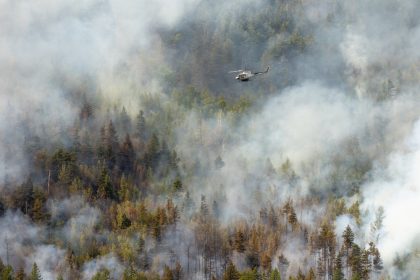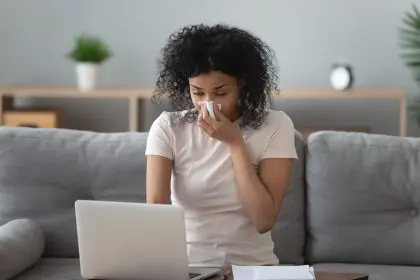When common allergies progress beyond typical symptoms, they can develop into more serious respiratory conditions requiring medical intervention. Allergic bronchitis represents a concerning progression where allergen exposure leads to inflammation of the bronchial tubes carrying air to the lungs. This condition affects millions of Americans annually, with increasing prevalence in areas with higher air pollution levels and during peak allergy seasons.
The immune system response behind allergic bronchitis
Allergic bronchitis develops when the immune system misidentifies harmless substances as threats. This triggers an inflammatory cascade affecting the respiratory system, particularly the bronchial tubes connecting the trachea to the lungs.
Unlike common allergies that primarily affect the upper respiratory tract, allergic bronchitis inflammation reaches deeper into the breathing passages. The bronchial tubes swell and produce excess mucus in response to allergen exposure, narrowing airways and making breathing difficult. Without proper management, this inflammation can become chronic, persisting for months or years.
Recent medical research indicates that approximately 25% of people with seasonal allergies may develop some degree of bronchial inflammation during peak exposure periods. This risk increases significantly in individuals with asthma or other pre-existing respiratory conditions.
7 critical symptoms requiring medical attention
The first warning sign involves persistent wet coughing that produces mucus. Unlike dry coughs associated with common colds, allergic bronchitis coughs typically bring up clear or whitish phlegm. This productive cough often worsens at night or early morning and may continue for weeks without improvement.
Second, wheezing sounds during breathing indicate narrowed airways. This high-pitched whistling noise occurs particularly during exhalation and often intensifies with physical activity or exposure to cold air. Wheezing represents a significant warning sign that bronchial inflammation has progressed beyond mild irritation.
The third symptom manifests as chest tightness or pressure. Patients frequently describe this sensation as feeling like a band constricting around their chest. This discomfort may fluctuate throughout the day but typically worsens following allergen exposure or during respiratory infections.
Fourth, shortness of breath during routine activities signals reduced lung function. When climbing stairs, carrying groceries, or performing other everyday tasks becomes increasingly difficult, the condition may have progressed significantly. This symptom warrants immediate medical evaluation, particularly when it develops suddenly.
Fifth, persistent fatigue affects many allergic bronchitis sufferers. The combination of poor sleep quality due to nighttime symptoms and increased energy expenditure from labored breathing leads to significant exhaustion. This fatigue can impact work performance, daily activities, and overall quality of life.
The sixth symptom involves recurring respiratory infections. Inflamed bronchial passages become more vulnerable to bacterial and viral infections, leading to frequent bouts of bronchitis or pneumonia. Patients may notice that common colds consistently develop into more serious chest infections requiring antibiotics.
Finally, the seventh warning sign includes concurrent classic allergy symptoms. Most allergic bronchitis patients simultaneously experience itchy, watery eyes, runny nose, frequent sneezing, and occasionally skin rashes. These symptoms often precede or accompany the respiratory manifestations.
Common triggers and environmental influences
Several environmental factors can initiate or worsen allergic bronchitis symptoms. Tobacco smoke tops the list of irritants, with both firsthand and secondhand exposure significantly increasing inflammation in sensitive airways. Research shows that smokers experience more severe and prolonged bronchitis episodes than non-smokers.
Air pollution represents another major trigger, particularly in urban environments. Particulate matter, ozone, nitrogen dioxide, and sulfur dioxide can all penetrate and irritate the respiratory system. During high pollution days, emergency room visits for respiratory conditions increase by approximately 20% in major metropolitan areas.
Indoor allergens prove particularly problematic since exposure tends to be continuous. Dust mites, pet dander, cockroach particles, and mold spores accumulate in homes, creating persistent allergen exposure. Controlling these triggers requires comprehensive environmental modifications.
Occupational exposures contribute to many cases of allergic bronchitis. Workers in manufacturing, agriculture, construction, and chemical industries face higher risks from exposure to industrial dusts, fumes, and chemicals. Proper respiratory protection and workplace controls can significantly reduce these risks.
Seasonal pollen from trees, grasses, and weeds triggers symptoms in millions of Americans. Climate change has extended pollen seasons in many regions, with some areas experiencing increases of up to 20 days in annual pollen duration over the past decade.
Effective treatment approaches for lasting relief
Treatment strategies depend on symptom severity and underlying causes. For mild cases, over-the-counter remedies can provide temporary relief. These include throat lozenges containing local anesthetics, honey-based herbal teas with anti-inflammatory properties, and expectorant cough medicines that thin mucus.
Prescription medications offer more targeted relief for moderate to severe symptoms. Bronchodilators open constricted airways by relaxing the surrounding muscles, improving airflow immediately. These medications come in short-acting forms for quick symptom relief and long-acting versions for ongoing management.
Anti-inflammatory corticosteroids reduce bronchial swelling and mucus production when used consistently. Inhaled formulations deliver medication directly to affected airways while minimizing systemic absorption. For severe flares, oral steroids may be prescribed for short courses to quickly reduce inflammation.
Mucolytics help break down thick mucus, making it easier to clear from airways. These medications reduce the viscosity of bronchial secretions, improving cough effectiveness and reducing the sensation of chest congestion.
Allergen immunotherapy represents a long-term solution for many patients. This treatment gradually desensitizes the immune system through controlled allergen exposure, reducing or eliminating the inflammatory response over time. Success rates exceed 85% for many common allergens when patients complete the full treatment course.
Prevention strategies for protecting vulnerable airways
Preventing allergic bronchitis requires a multifaceted approach focusing on allergen avoidance and respiratory health. Identifying specific triggers through allergy testing allows for targeted environmental modifications. Blood tests and skin prick testing can identify specific allergens causing reactions.
Improving indoor air quality significantly reduces symptom frequency. High-efficiency particulate air (HEPA) filters remove 99.97% of airborne particles measuring 0.3 micrometers or larger. Regularly replacing furnace filters, controlling humidity levels, and removing carpet can further reduce indoor allergen load.
Smoking cessation provides immediate and long-term benefits for respiratory health. Within one week of quitting, bronchial sensitivity begins decreasing, with continued improvement over several months. Avoiding secondhand smoke environments proves equally important for preventing symptom flares.
Regular exercise strengthens respiratory muscles and improves lung capacity when performed appropriately. Low-impact activities like swimming, walking, and cycling benefit respiratory health without triggering symptoms. Starting slowly and gradually increasing intensity minimizes risk of exercise-induced symptoms.
Maintaining current vaccinations prevents infections that can worsen bronchial inflammation. Annual influenza vaccines and pneumonia vaccinations reduce the risk of respiratory infections that often trigger severe bronchitis flares in vulnerable individuals.
When to seek immediate medical help
Certain symptoms require prompt medical attention. Severe breathing difficulty or inability to speak in complete sentences indicates potentially dangerous airway narrowing requiring emergency care. Bluish discoloration of lips or fingernails signals dangerously low oxygen levels demanding immediate treatment.
Chest pain accompanying respiratory symptoms warrants thorough evaluation to rule out cardiac causes. While bronchitis itself can cause chest discomfort, distinguishing between respiratory and cardiac pain requires professional assessment.
Fevers exceeding 100.4 degrees Fahrenheit may indicate infection complicating allergic inflammation. When combined with respiratory symptoms, fever suggests possible pneumonia requiring antibiotic treatment and close monitoring.
Coughing producing green or yellow mucus indicates bacterial infection requiring medical evaluation. This discolored sputum represents inflammatory cells and bacteria, distinguishing it from the clear or white mucus typically seen in allergic bronchitis alone.
With proper management, most allergic bronchitis patients achieve good symptom control and prevent progression to chronic conditions. Early recognition of warning signs, prompt treatment, and consistent preventive measures protect respiratory health and maintain quality of life despite allergic tendencies. Working closely with healthcare providers allows for personalized treatment approaches addressing individual triggers and symptoms most effectively.
















